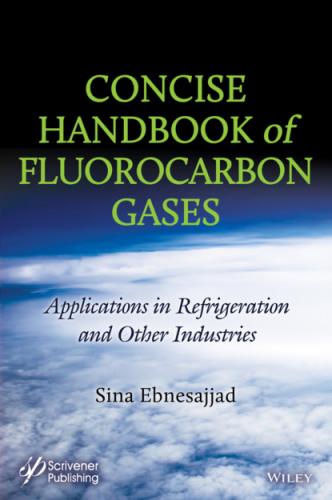9. Refrigerant Market Size Worth $30.37 Billion By 2025 at CAGR: 5.3%, Refrigerant Market Size & Share Report By Product (Fluorocarbon, Hydrocarbon, Inorganic), Grand View Research, www.grandviewresearch.com, May 2020.
10. Refrigerant Market by Type, and by Application - Global Trends & Forecasts to 2020, MarketsandMarkets, www.marketsandmarkets.com.
11. Global Market Insights, www.gminsights.com, Fluorochemicals Market Size by Product, by Application, Industry Outlook Report, 2015–2024.
12. Micromarket Monitor, www.micromarketmonitor.com, Nov 2019.
13. Global $31 Billion Refrigerants Market Forecast to 2023, published by CISION PR, www.prnewswire.com, March 2019.
14. CHILLVENTA Insights - The Market Analysis, www.chillventa.de, 2019.
15. Chemical Economics Handbook, HIS Markit, https://ihsmarkit.com, 2019.
16. Fluoropolymers Market - Global Industry Trends & Forecasts to 2019 www.marketsandmarkets.com, 2019.
17. Fluoropolymers - Chemical Economics Handbook (CEH) |HS, www.ihs.com, 2019.
18. India Fluoropolymer & Fluorosurfactant Market Report, www.grandviewresearch.com, 2019.
19. Fluoroelastomer Market - Global Trends & Forecast to 2019, www.marketsandmarkets.com, May 2019.
20. Fluoroelastomers, Chemical Economics Handbook, IHS Markit, https://ihsmarkit.com/products/fluoroelastomers-chemical-economics-handbook.html, April 2019.
21. Fluoropolymer Coating Market Report - Global Forecast till 2025, www.marketresearchfuture.com/reports/flouropolymer-coating-market-4844, ID: MRFR/CnM/3416-HCR, May 2020.
22. Kissa, E., Fluorinated Surfactants: Synthesis, Properties, Applications, 2nd ed, CRC Press, 2001. 23. Gakh, A. and Kirk, K.L., Fluorinated Heterocycles, 1st ed, American Chemical Society, 2009. 24. Knepper, T.P. and Lange, F.T., Polyfluorinated Chemicals and Transformation Products, in: The Handbook of Environmental Chemistry, 2012 Ed, Springer, 2011.
23. Ameduri, B. and Boutevin, B., Well-Architectured Fluoropolymers: Synthesis, Properties and Applications, 1st ed, Elsevier Science, 2004.
24. Regulation (EC) No 842/2006 of The European Parliament and of the Council of 17 May 2006 on certain fluorinated greenhouse gases. Off. J. Eur. Union, 2006.
25. Directive 2006/40/EC of The European Parliament and of the Council of 17 May 2006 relating to emissions from air-conditioning systems in motor vehicles and amending Council Directive 70/156/EC. Off. J. Eur. Union, 2006.
2
Classification and Description of Commercial Fluorinated Compounds
Fluorine is present in the air we breathe, the water we drink and the rocks beneath us, as well as in numerous synthetic polymers, pharmaceuticals, agrochemicals and other formulations. Fluorine in the atmosphere, oceans, biosphere and earth’s crust might be grouped together as the fluorosphere to understand the effects of human activities on the environment [1].
This chapter begins with a short discussion of sources of fluorinated chemicals. Most existing fluorochemicals are organic and virtually all of them are synthetic, that is manufactured. Fluorochemicals as a class of materials are fairly new; all of them have been produced since 1930’s. The rest of this chapter primarily covers fluorocarbon gases and liquids. A short explanation of commercial fluoropolymers rounds off the Chapter.
2.1 Fluorine and Fluorochemicals
Organic fluorine compounds rarely occur naturally in contrast to bromine and chlorine products. The most famous naturally existing organic fluorine-containing compound is probably monofluoroacetic acid (FCH2COOH). This compound is found in a South African plant called “Gifblaar,” which is known to be so poisonous that ingesting only a half of its leaf is enough to kill a cow. In 2003, a Chinese research group discovered fluorine-containing compounds from the extract of a marine sponge called Phakellia fusca. Another example of a naturally occurring organic fluorine containing compound is called nucleocidin. Even the presence of elemental fluorine has been reported in fluorspar (CaF2) containing radioactive uranium [2].
None of the rare natural organic compounds are useful as a source for C-F bonds for commercial production of chemicals. The easiest route to produce carbon fluorine (C-F) bond is via hydrofluoric acid (HF). Acid grade fluorspar (CaF2) is combined with sulfuric acid to produce HF and calcium sulfate. Chloroform is produced by and chlorination of methane. Catalytic reaction of HF and CHCl3 produces CHClF2, which is the starting point for producing many fluorocarbons.
2.2 Fluorocarbons
Development of fluorine chemistry allowed economically viable fluorinated chemicals and polymers to be produced during the first half of 20th century. The first commercial fluorine products of any kind go back to 1930’s, developed to meet the evolving industrial needs for compounds such as new refrigerants. The traditional agents used in refrigeration included ammonia, carbon dioxide, sulfur dioxide, hydrocarbons and methyl chloride. These refrigerants suffered from shortcomings including toxicity, flammability, instability and poor efficiency in the refrigeration cycle. Consequently, the challenges in the development of new agents consisted of the following characteristics:
1 Non-flammable
2 Good thermal stability
3 Low toxicity
4 Atmospheric boiling point of -40°C to 0°C
5 Refrigeration cycle efficiency
Some of the early patents described methods using rather exotic compounds to produce fluorocarbons [3, 4]. Simpler preparation methods have been described for the reaction of hydrofluoric acid with halocarbons (chlorine and bromine) using a catalyst [5].
Fluorocarbon in this book refers an acyclic alkane hydrocarbon in which all or some of hydrogen atoms have been replaced with fluorine (Table 2.1). An acyclic alkyl has the general formula CnH2n+1. Some chlorine or bromine atoms may also be present in the molecule. Depending on the structure of chemical compound, fluorocarbon consists of chlorofluorocarbon (CFC), hydrochlorofluorocarbon (HCFC), hydrofluorocarbon (HFC) and hydrofluoroolefin (HFO). All except HFO have been the targets for obsolescence under Montreal Protocol and its amendments. Major fluorocarbon applications include refrigerants, blowing, agents (foam), solvents, aerosol propellants and fire extinguishers.
Chlorofluorocarbons contain Carbon and some combination of Fluorine and Chlorine atoms. They were the original fluorocarbons developed in the 1930’s. Hydrochlorofluorocarbons contain Hydrogen, Chlorine, Fluorine, and Carbon atoms; they were quickly developed and commercialized after the enactment of the Montreal Protocol. Hydrofluorocarbons contain Hydrogen, Fluorine,
